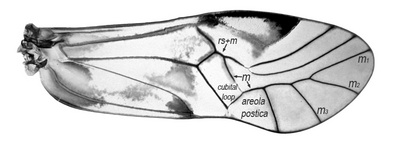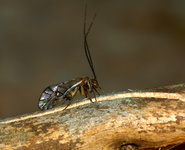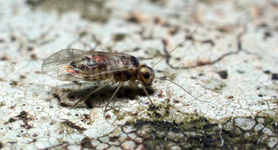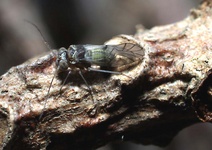Psocidae
Bark Lice
Emilie Bess and Kevin P. Johnson- Amphigerontiinae
- Amphigerontia
- Anomaloblaste
- Blaste
- Blastopsocidus
- Blastopsocus
- Chaetopsocidus
- Chaetopsocidus sturmi
- Chilopsocus
- Chilopsocus macrochilus
- Disopsocus
- Disopsocus megacheilus
- Elaphopsocus
- Elaphopsocus glaphyrostigma
- Elytropsocus
- Elytropsocus coleoptratus
- Epiblaste
- Euclismioides
- Euclismioides inocellata
- Indoblaste
- Javablaste
- Kaindipsocus
- Lasiopsocus
- Metagerontia
- Metagerontia tribulosa
- Neoblaste
- Neopsocopsis
- Pentablaste
- Stylatopsocus
- Psocinae
- Cerastipsocini
- Cerastipsocus
- Ceratostigma
- Ceratostigma gracile
- Cervopsocus
- Cervopsocus medialis
- Clematoscenea
- Dactylopsocus
- Dinopsocus
- Eremopsocus
- Ghesquierella
- Longivalvus
- Lubricus
- Lubricus dayaoshanensis
- Neopsocus
- Podopterocus
- Podopterocus longicornis
- Pogonopsocus
- Pogonopsocus octofaris
- Propsococerastis
- Propsococerastis jiangkouensis
- Pseudoclematus
- Pseudoclematus xanthoznatus
- Psococerastis
- Setopsocus
- Setopsocus magnus
- Sundapsocus
- Sundapsocus robertsoni
- Cycetini
- Cycetes
- Metylophorini
- Brachinodiscus
- Brachinodiscus cinctipes
- Cyclotus
- Cyclotus microcorneus
- Diplacanthoda
- Diplacanthoda bouvieri
- Metylophorus
- Ophthalmopsocus
- Pearmania
- Pilipsocus
- Sigmatoneura
- Brachinodiscus
- Psocini
- Atrichadenotecnum
- Atropsocus
- Atropsocus atratus
- Cryptopsocus
- Cryptopsocus cynostigmus
- Hyalopsocus
- Psocus
- Sacopsocus
- Sacopsocus quadricornis
- Ptyctini
- Atlantopsocus
- Barrowia
- Barrowia insularis
- Camelopsocus
- Cephalopsocus
- Cephalopsocus cassideus
- Clematostigma
- Conothoracalis
- Copostigma
- Fashenglianus
- Fashenglianus albimaculatus
- Hybopsocus
- Hybopsocus bisipolaris
- Indiopsocus
- Javapsocus
- Loensia
- Mecampsis
- Oreopsocus
- Pseudoptycta
- Pseudoptycta pinicola
- Psocidus
- Psocomesites
- Ptycta
- Sciadionopsocus
- Sciadionopsocus fenzelianae
- Steleops
- Symbiopsocus
- Tanystigma
- Trichadenopsocus
- Trichadenotecnum
- Cerastipsocini
- Thyrsophorinae
- Dictyopsocus
- Dictyopsocus pennicornis
- Gigantopsocus
- Gigantopsocus metallicus
- Poecilopsocus
- Thyrsophorus
- Thyrsopsocus
- Dictyopsocus
Introduction
The family Psocidae is the largest family of Psocodea, containing over 60 genera and over 900 described species worldwide. These are small to large-sized bark lice (2-8 mm) with diverse morphology. Most species live on bark, but a few are ground dwelling. Psocidae includes the largest species of bark louse, in the South American genus Thyrsophorus.
Psocidae contains three subfamilies: Psocinae and Amphigerontiinae (distributed worldwide), and Thyrsophorinae (Central and South America and recently found in Vietnam).
Characteristics
Synapomorphies:
- Presence of an articulation between hypandrium and clunium.
- Presence of the posterior lobe of the external valve of the gonapophyses.
Head:
- Antennae 13-segmented.
- Tarsi 2-segmented; tarsal claws toothed or not.
Wings:
- Cubital loop always joined to M for a distance in the forewing.
- M in forewing with three branches.
- Forewings nearly always glabrous; setae sparse and small if present.
- Aerola postica joined to the media by fusion of CuAI with the media.
- Hindwing nearly always glabrous except for few setae between R2,3 and R4,5.


Forewing of Ptycta conforma. Cubital loop and areola postica joined to M is typical of the family Psocidae.
The fusion of veins Rs,M distinguishes the genus Ptycta the sister genus Copostigma.
Male:
- Paraprocts of male with strongly developed clasper-like processes
- Male hypandrium is ornamented variety of forms: teeth, apophyses, hooks, spines, grooves, ridges and tubercles – symmetrical or not.
- Phallosome usually fairly simple structure closed before and behind, with minimal scleritosation for penial bulb.
- Males of Amphigerontiinae with heavily sclerotised anterior abdomen.
Female:
- Gonapophyses are complete and well developed.
- Ventral valve is pointed.
- Dorsal valve broader than the ventral valve, usually ‘fleshy’ in appearance and apically pointed or rounded.
- External valve is large, well developed and setose.
- Eggs laid single or in groups, covered with encrustation and occasionally, also with silk.
Psocidae Monophyly
The monophyly of Psocidae is supported by both molecular and morphological data. In a molecular analysis that included three Psocinae genera (Loesnia, Metylophorus, and Trichadenotecnum) and one genus of Amphigerontiinae (Blastopsocus) with a data set that combined 18S rDNA, and 12S, 16S, COI rDNA, Johnson and Mockford (2003) found Psocidae to be monophyletic. (The subfamily Thyrsophorinae has not been included in molecular analyses.) Morphological data support the monophyly of Psocidae based on the presence of an articulation between hypandrium and clunium and the presence of the posterior lobe of the external valve of the gonapophyses (Yoshizawa, 2002).
Discussion of Phylogenetic Relationships
Although the phylogenetic relationships within Psocidae have not been studied extensively, 18S rDNA strongly supports the monophyly of Amphigerontinae (based on three genera: Amphigerontia, Blaste, and Blastopsocus). However, Amphigerontinae is embedded within the Psocinae, suggesting paraphyly of Psocinae (Johnson et al. 2004). There is no morphological evidence for the monophyly of Psocinae (Yoshizawa, pers. comm.).
References
Johnson, K. P. & E. L. Mockford. 2003. Molecular systematics of Psocomorpha (Psocoptera). Systematic Entomology 28: 409-40.
Johnson, K. P., K. Yoshizawa, and V.S. Smith. 2004. Multiple origins of parasitism in lice. Proceedings of the Royal Society of London. B. 271: 1771?1776.
Lienhard, C. and C. N Smithers. 2002. Psocoptera (Insecta) World Catalogue and Bibliography. Mus?um d'Histoire Naturelle, Geneva, Switzerland.
Mockford, E. L. 1993. North American Psocoptera (Insecta). Gainesville, Florida: Sandhill Crane Press.
Smithers, C. N. 1996. Psocoptera. Pp. 1-80, 363-372 (Index) in Wells A. (ed.) Zoological Catalogue of Australia. Vol. 26. Psocoptera, Phthiraptera, Thysanoptera. Melbourne: CSIRO Publishing, Australia.
Yoshizawa, K. 2002. Phylogeny and higher classification of suborder Psocomorpha (Insecta: Psocodea:'Psocoptera'). Zoological Journal of the Linnean Society 136: 371-400.
Information on the Internet
- Psoco Net: The Psocidologists' Home Page. The latest information on Psocoptera taxonomy and reserchers in the Psocoptera community, maintained by Dr. Kazunori Yoshizawa, Hokkaido University, Sapporo, Japan.
- Discover Life: Psocoptera Page
- Dr. Charles Lienhard. Psocid expert at the Natural History Museum, Geneva, Switzerland.
- Dr. Edward Mockford. Expert on Psocids of North America and beyond, Illinois State University.
- Dr. Kevin Johnson. Expert on molecular systematics of Psocids and parasitic lice, Illinois Natural History Survey.
- Emilie Bess. Research on Psocids of Hawaii and elsewhere, University of Illinois.
Title Illustrations

| Scientific Name | Psococerastis sp. |
|---|---|
| Location | Nokonoshima Island, Kyushu, Japan |
| Specimen Condition | Live Specimen |
| Identified By | K. Yoshizawa |
| Sex | Male |
| Life Cycle Stage | adult |
| View | dorsal |
| Size | 4mm |
| Copyright | © 2006 Kazunori Yoshizawa |
| Scientific Name | Blaste sp. |
|---|---|
| Location | Nokonoshima Island, Kyushu, Japan |
| Specimen Condition | Live Specimen |
| Identified By | K. Yoshizawa |
| Life Cycle Stage | adult |
| View | dorsal |
| Size | 3mm |
| Copyright | © 2006 Kazunori Yoshizawa |
| Scientific Name | Ptycta conforma |
|---|---|
| Location | Nokonoshima Island, Kyushu, Japan |
| Specimen Condition | Live Specimen |
| Identified By | K. Yoshizawa |
| Sex | Male |
| Life Cycle Stage | adult |
| View | dorsal |
| Size | 4mm |
| Copyright | © 2006 Kazunori Yoshizawa |
About This Page
Emilie Bess

Illinois Natural History Survey, Champaign, Illinois, USA
Kevin P. Johnson

Illinois Natural History Survey, Champaign, Illinois, USA
Correspondence regarding this page should be directed to Emilie Bess at and Kevin P. Johnson at
Page copyright © 2006 Emilie Bess and Kevin P. Johnson
- First online 11 October 2006
Citing this page:
Bess, Emilie and Johnson, Kevin P. 2006. Psocidae. Bark Lice. Version 11 October 2006 (under construction). http://tolweb.org/Psocidae/14482/2006.10.11 in The Tree of Life Web Project, http://tolweb.org/












 Go to quick links
Go to quick search
Go to navigation for this section of the ToL site
Go to detailed links for the ToL site
Go to quick links
Go to quick search
Go to navigation for this section of the ToL site
Go to detailed links for the ToL site